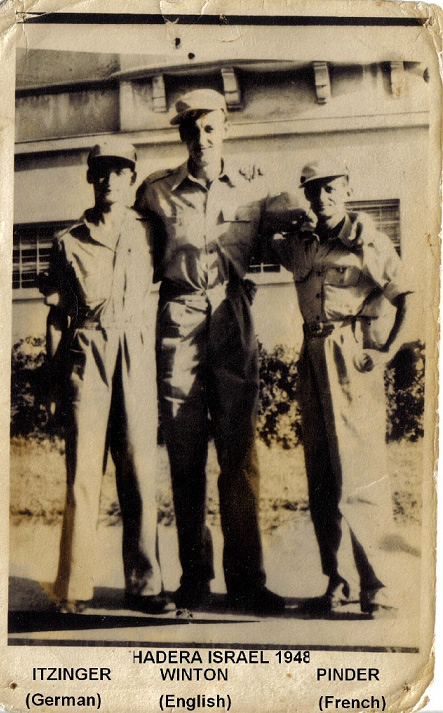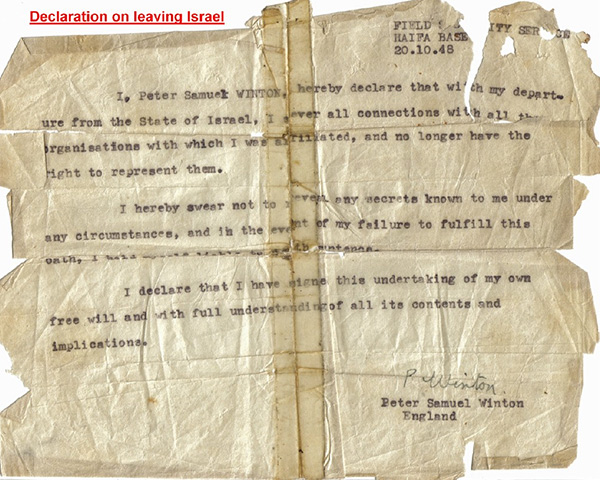
PETER SAMUEL WINTON
Military No: 55155
7th July 1948 – L-R Mendel Itzinger (Germany/UK), 72nd Battalion Infantry
Peter Samuel Winton, 7th Brigade, Shalom Pinder (France) – Hadera
Peter Samuel Winton was born in Worthing, West Sussex, England, on 23rd May 1927, and was educated there. He was brought up as a Christian.
At the age of 16 Peter went to sea with the British Merchant Navy, and was involved in the Atlantic Convoy runs, which were hazardous, to say the least. At the end of the war on VE day, Peter was in Montevideo dressed as a ballerina performing at the city hall as a member of a ship’s revue party for local dignitaries. The ship he served on was the “Norman Star” and the members of the cast of the revue were called “The Normaniacs.”
Peter continued his service with the Merchant Navy and on 10th October 1947 he was in Staten Island, USA, but he left his ship (“Esso Elisabeth”) and went to Baltimore, where he tried to enlist in the US Army. Unfortunately for him, it was the beginning of the Cold War tensions and his efforts to join were rewarded by being ‘detained’ in the Baltimore Jail for 10 weeks whilst his identity was verified. Once verified, he was “requested” to leave the USA, which he did on 6th February 1948.
In April 1948 he left the Norwegian ship the “S/S Norse Mountain” at Port-de-Bouc, and later boarded an Aliyah Bet ship, the “Pan York,” joining in the struggle to help displaced people to reach Palestine before joining the 7th Brigade.
From a letter Peter wrote to his son John:
Left ship in Port-de-Bouc near Marseilles around March/April 1948.
Went into Grand Arenas camp not far away as a non-Jewish volunteer to crew ships carrying DPs (Displaced Persons), Jewish slave labor survivors who had been forced to work in German industries all over occupied Europe during World War II. The countries of Europe were re-organizing after the war, and wanted these to get rid of these workers. They were mainly Jewish, from all the countries which had been invaded by the Germans, and they were desperate to get to Eretz Yisrael. These refugees poured in from all over Europe, and included Mischka Yanowitski, whom I was to meet in 1956 on the Israeli ship “Dvora.”
The Jews in the USA had purchased ten ‘Rust Buckets’ which included the “Pan York” and the “Pan Crescent” (originally named “Kibbutz Galuyot” and “Atzmaut”). I joined the “Pan York.”
We carried 600 people in each of the four holds (2,400 people in all), and set up communal bunks. Conditions were “barbaric,” but after what most of them had been through, it was “paradise” because they were “going home.” They were brought to the ship on trucks, each one carrying about 20 refugees, and the journey was a few hours’ drive from the camp. One of the group leaders was a Romanian Jewess, aged 18, who spoke English. As a student four years earlier, she and an older sister did war work. The remainder of her family, parents and a younger brother, were murdered. She was very attractive, and had the concentration camp number tattooed on her wrist. Since her arrest she never saw any of her family again, including an older sister. Her story was just one of the millions of stories from the Holocaust.
I promised I would look her up in Israel. While on the ship I smuggled a few extra goodies to her and her group. After we landed, they went one way and I went the other way with some volunteers to join the Israeli military. By then, six Arab armies had invaded Israel. I thought that the Israeli army needed me. The first cease-fire monitored by the U.N. started on 11th June.
I visited a few kibbutzim, but never found my Romanian. She might have even been in the army. Previously, she had been stateless. I could have made her British. I was only 21 and she was 18. She is still clear in my mind and if she is still alive she would be about 70 years old now.
On 20th October 1948 we left on the “Negbah.” She and her sister ship the “Kedmah” had set up a “luxury” ferry from Marseilles and Trieste in Italy to Haifa, so I was there from May to October. The Israelis had funded six or seven of us ex-IDF soldiers, so I went up to Paris.
In October 1948 Peter left Israel to return to the UK, and signed the following declaration prior to his departure:

Leaving Israel on the “Negbah,” he was careful to avoid the British authorities due to his duties in Israel, and went to Paris with others. As he told his children: “Israel had funded us, some six or seven ex-IDF volunteers. Anyway, figuring that ‘men with big feet’ (the police) would be in Dover looking for ex-pat deserters, I took a train to Hoek van Holland, and went on through Belgium, and on arrival at Harwich mingled with other merchant seamen to get back into Britain.” This was December 1948.
Peter continued travelling the world as a merchant seaman, and in 1951 he jumped ship in Hobart, Tasmania and joined the Australian Army. He spent three years at the Kapooka Camp near Wagga Wagga, leaving Australia on 30th July 1954. He then continued as a merchant seaman and travelled extensively. He joined an Israeli ship (after checks found he was ‘Israel Friendly’) the “Dvora” sometime around August/September 1955, and was caught up in an ‘incident’ with the ship and Interpol.
He continued in the British Merchant Navy until he left to marry Rita Sandell in 1959, and they had three children, John, Brian and Kathleen. Peter died on 2nd May 2002.
Source: John Peter Winton, Peter Samuel’s son

